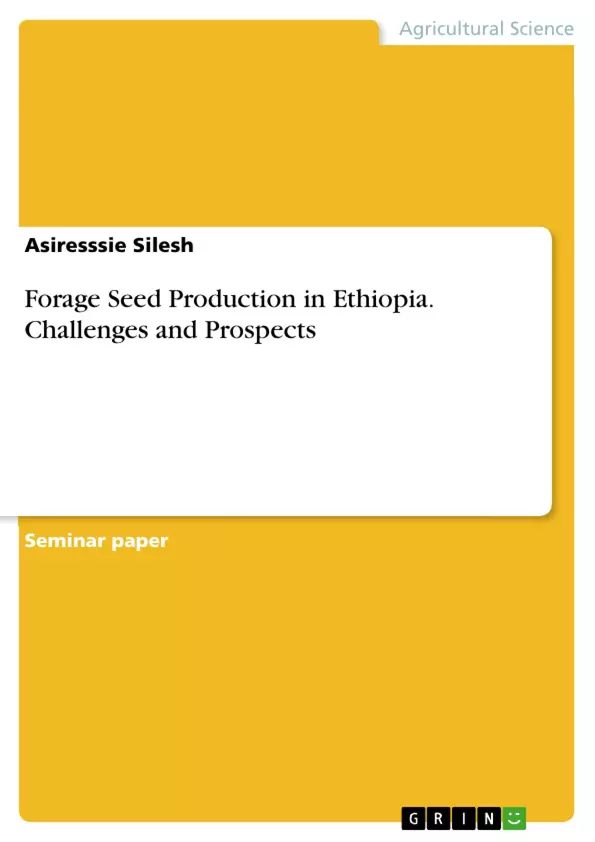This term paper aims to investigate challenges and prospects of forage seed production in Ethiopia.
Seed production of forage species is a much earlier and less developed stage in the tropics and subtropics than in temperate regimes. Many of the current tropical forage cultivars were developed 50 years ago. Most of these grasses come from species new to agriculture. They have not undergone long period of domestication through hybridization and selection. Instead, they still retain many "wild characteristics" – attributes which aid their natural spread but pose difficulties for their commercial seed production. All of this poses a challenge to seed producers who must decide where the various crops should be grown for seed, the best management strategy to apply in each case and when and how they should be harvested to maximize seed yield and quality. Forage seed productions in tropical regions are characterized by variable production. Seed yield instability of the species may be a consequence of the contrasting environmental conditions that occur during the vegetative and reproductive growth of the crops.
Inhaltsverzeichnis (Table of Contents)
- INTRODUCTION
- Objective.
- LITERITURE REVIEW.
- Status of farmers' perception towards improved forage adoption
- Improved forages production practice
- Purpose and utilization of improved forages
- Improved forage production strategies
- Backyard forage production..
- Under-sowing and inter-planting .
- Contour forage strips.
- Types of forage seed production......
- Farmer-based forage seed production.
- Forage seed production by government agencies
- Challenges of forage seed production ...
- Prospects for improved forage seed production........
- CONCLUSION.
- REFERENCES
Zielsetzung und Themenschwerpunkte (Objectives and Key Themes)
This paper aims to provide a comprehensive review of forage seed production studies in Ethiopia, focusing on the challenges and prospects associated with this practice. It examines various aspects of forage seed production, including farmers' perception of improved forage adoption, improved forage production practices, the purpose and utilization of improved forages, and challenges and prospects in seed production.
- Challenges and prospects of improved forage seed production in Ethiopia
- Farmers' adoption and perception of improved forage technologies
- Improved forage production practices and their influence on seed production
- The role of improved forages in animal production, soil health, and sustainable agriculture
- Strategies for enhancing forage seed production and addressing existing challenges
Zusammenfassung der Kapitel (Chapter Summaries)
- Introduction: This chapter provides an overview of forage seed production in tropical regions, highlighting the challenges and importance of this practice. It emphasizes the need for improved management strategies to enhance seed yield and quality.
- Literature Review: This chapter delves into the status of farmers' perception towards improved forage adoption in Ethiopia. It examines various research findings related to improved forage production practices, including the adoption rates, major forage species cultivated, and the factors influencing their adoption. It also explores the purpose and utilization of improved forages, highlighting their benefits for animal production, soil fertility, and sustainable agriculture.
Schlüsselwörter (Keywords)
This review centers on the key themes of forage seed production, improved forage adoption, challenges and prospects, farmers' perception, production practices, and the utilization of improved forages in Ethiopia. It also addresses relevant concepts such as sustainable agriculture, soil health, and livestock production.
- Quote paper
- Asiresssie Silesh (Author), 2021, Forage Seed Production in Ethiopia. Challenges and Prospects, Munich, GRIN Verlag, https://www.grin.com/document/1150914



